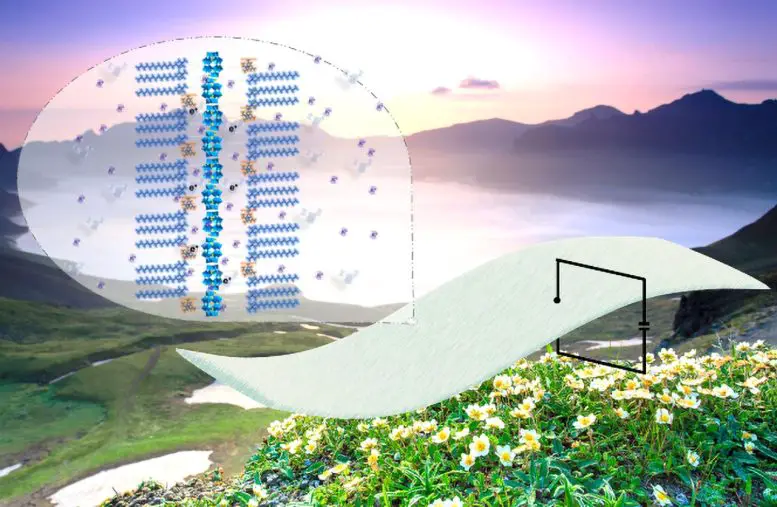The polyoxometalate power generator collects the natural atmospheric humidity and produces continuous electrical signals by the uneven distribution and directional movement of ions, realizing efficient collection and utilization of low-value energy. Credit: Nana Research, Tsinghua University Press
Scientists have created a power generator that uses atmospheric humidity and polyoxometalates to produce continuous electricity, offering a sustainable way to utilize low-value energy.
Scientists are exploring methods to harness the low-value energy found abundantly in natural environments to produce electricity. A groundbreaking development has emerged: a power generator that leverages natural atmospheric humidity and produces continuous electrical signals. Remarkably, this is the first humidity generator that employs a nano-sized material known as polyoxometalates. The implications of this discovery suggest a promising new avenue of research in the sustainable exploitation of low-value energy.
The findings of this research were recently showcased in the journal Nano Research.
The researchers embarked on this journey to address the inconsistency observed in the performance of energy conversion gadgets. A pressing issue they tackled was the dearth of materials designed for atmospheric humidity power generation and the limitations these materials posed. Professor Weilin Chen from the Department of Chemistry at Northeast Normal University elaborated, “We wanted to understand the conversion process of atmospheric humidity energy to electrical energy and the role of polyoxometalates in the atmospheric humidity power generation.”
Understanding Polyoxometalates and Their Potential
Polyoxometalates, known as POMs, have unique morphology and functional properties, which make them especially useful in controllable synthesis, assembly, and performance research. They are a versatile class of inorganic molecular materials. POM nanomaterials can self-assemble to form microporous structures that are capable of collecting atmospheric humidity. They are also environmentally friendly, with great stability in light, heat, and chemical environments. Researchers expect that POM nanomaterials are the materials with the potential to effectively utilize atmospheric humidity.
The scientists constructed POMs into organic ammonium-polyoxoanion clusters. The clusters were assembled into thin films power generators with tiny, nano-sized pores called micropores, that are capable of working in atmospheric humidity. Their tiny POM generator produced a voltage of 0.68 V, was stable, and worked continuously under almost all-natural environments, with atmospheric humidity ranging from 10 percent to 90 percent.
Working Mechanism and Potential Applications
The POM atmospheric humidity generator works as the POM nanoclusters spontaneously absorb atmospheric humidity with the micropores in POM nanowires films. They form a distribution gradient of water which is the structural basis of power generation. The POM generator has proven to have high stability and continuous power generation performance.
The team determined that the POM power generator can effectively collect the natural atmospheric humidity and produce continuous electrical signals by the uneven distribution and directional movement of ions. This work provides new ideas for the continuous use of low-value energy and a new research angle for polyoxometalate chemistry.
There has been an urgent need to develop a continuous low-value energy in a natural environment. In past research, scientists have created devices that collect and use low-value energy. However, these devices have been limited because low-value energy is intermittent and unstable. In recent years, scientists have made progress in their use of atmospheric humidity energy. However, the team’s POM generator is the first humidity generator to produce continuous power.
This revolutionary POM generator has many potential applications, such as the detection of human respiratory processes; the detection, recording, and alarm of environmental humidity; the integration with electrical appliances to achieve continuous power supply of equipment; and meeting the electricity needs of multiple scenarios.
“The most important message is that continuous power generation using atmospheric humidity has been achieved through the design and modification of POMs nanomaterials, and the mechanism of atmospheric humidity power generation has been deeply understood by using the characteristics of POMs nanomaterials,” said Chen.
The Path Forward
Looking ahead, the researchers aim to improve the efficiency of atmospheric humidity power generation by screening and optimizing materials. They also want to achieve a deeper understanding of the atmospheric humidity power generation process.
“The ultimate goal is achieving the efficient use of humidity generators to promote sustainable development of energy and the environment by exploring the mechanism that optimizes the efficiency of the humidity generator,” said Chen.
Reference: “Polyoxometalates for continuous power generation by atmospheric humidity” by Tuo Ji, Weilin Chen, Zhenhui Kang and Liming Zhang, 1 August 2023, Nano Research.
DOI: 10.1007/s12274-023-5959-5
The Chinese research team includes Tuo Ji and Weilin Chen from the Northeast Normal University; Zhenhui Kang from Soochow University; and Liming Zhang from the Chinese Academy of Sciences.
The research is funded by the National Natural Science Foundation of China, Science and Technology Research Project of the Education Department of Jilin Province, and the Natural Science Foundation of Jilin Province.


